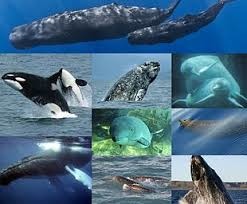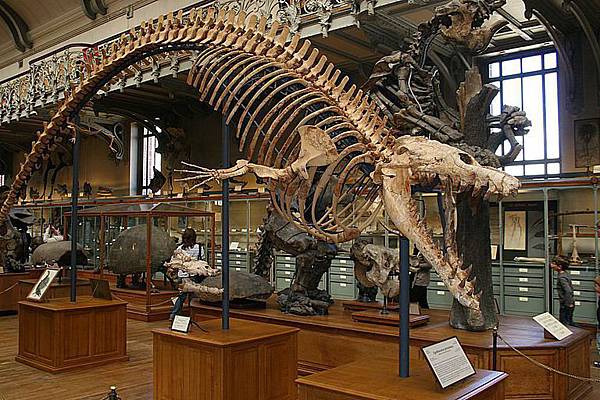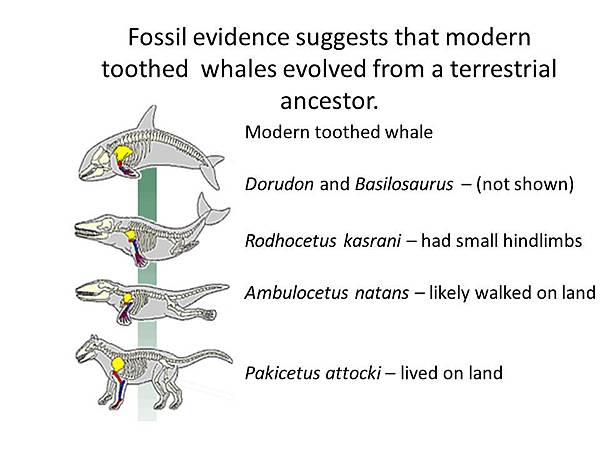![]() The Origins Of Cetaceans 鯨類動物起源 (1)
The Origins Of Cetaceans 鯨類動物起源 (1)
It should be obvious that cetaceans-whales, porpoises, and dolphins-are mammals. They breathe through lungs, not through gills, and give birth to live young. Their streamlined bodies, the absence of hind leg, and the presence of a fluke and blowhole cannot disguise their affinities with land dwelling mammals. However, unlike the cases of sea otters and pinnipeds (seals, sea lions, and walruses, whose limbs are functional both on land and at sea), it is not easy to envision what the first whales looked like. Extinct but already fully marine cetaceans are known from the fossil records. How the gap between a walking mammal and a swimming whale bridge? Missing until recently were fossils clearly international, or transitional, between land mammals and cetaceans.

Very exciting discoveries have finally allowed scientists to reconstruct the most likely origins of cetaceans. In 1979, a team looking for fossils in northern Pakistan found what proved to be the oldest fossils whale. The fossil was officially named Pakicetus in honor of the country where the discovery was made. Pakicetus was found embedded in rocks formed from river deposits that were 52 million years old. The river that formed these deposits was actually not far from an ancient ocean known as the Tethys Sea.
The fossil consists of a complete skull of an archaeocyte, an extinct group of ancestors of modern cetaceans. Although limited to a skull, the Pakicetus fossil provides precious details on the origins of cetaceans. The skull is cetacean-like but its jawbones lack the enlarged space that is filled with fat or oil and used for receiving underwater sound in modern whales. Pakicetus probably detected sound through the ear opening as in land mammals. The skull also lacks a blowhole, another cetacean adaptation for diving. Other features, however, show experts that Pakicetus is a transitional form fed on fish in shallow water and was not yet adapted for life in the open oceans. It probably bred and gave birth on land.

Another major discovery was made in Egypt in 1989. Several 14. skeletons of another early whale, Basilosaurus, were found in 15. sediments left by the Tethys Sea and now 16. exposed in the Sahara desert. This whale lived around 40 million years ago, 12 million years after Pakicetus. Many incomplete skeletoms were found but they included, for the first time in an archaeocyte, a complete hind leg that features a foot with three tiny toes. Such legs would have been far too small to have supported the 50-foot-long Basilosaurus on land. Basilosaurus was undoubtedly a fully marine whale with possibly nonfunctional, or 17. vestigial, hind legs.
An even more exciting find was reported in 1994, also from Pakistan. The now extinct whale Ambulocetus natans (“the walking whale that swam”) lived in the Tethys Sea 49 million years ago. It lived around 3 million years after Pakicetus but 9 million before Basilosaurus. The fossil luckily includes a good portion of the hind legs. The legs were strong and ended in long feet very much like those of a modern pinniped. The legs were certainly functional both on land and at sea. The whale retained a tail and lacked a fluke, the major means of locomotion in modern cetaceans. The structure of the backbone shows, however, that Ambulocetus swam like modern whales by moving the rear portion of its body up and down, even though a fluke was missing. The large hind legs were used for propulsion in water. On land, where it probably bred and gave birth, Ambulocetus may have moved around very much like a modern sea lion. It was undoubtedly a whale that linked life on land with life at sea.
1. Fluke: the two parts that constitute the large triangular tail of a whale
2. Blowhole: a hole in the top of the head used for breathing



 留言列表
留言列表